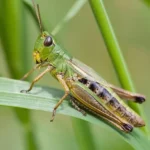
The shoebill, also known as the whalehead, whalehead stork or shoebill stork, is a very large stork-like bird. It owes its name to its huge, shoe-shaped beak. It has a general shape somewhat similar to that of a stork and was formerly classified with storks in the order Ciconiiformes based on this morphology. Shoebills can be found only in eastern parts of Africa, all the way from Sudan to Zambia. Shoebill prefers life in dense tropical swamps, marshes, and wetlands. Shoebill is listed as an endangered species, with no more than 8,000 birds in the wild.
It is known that shoebill storks are shy animals that prefer to be alone.
Shoebill is very large bird. It can be almost 5 feet tall, 4 feet long, reaching 1.5 pounds in weight.
The shoebill is piscivorous, primarily eating fish – in particular lungfish, as well as bichirs, tilapia and catfish.
Body of shoebill is covered with bluish-grey plumage. Shoebill has strong neck, long legs and broad wings.
The shoebill’s flapping when flying is one of the slowest of any birds, at a mere (approx.) 150 flaps per minute.
The most prominent feature on the shoebill’s body is its beak. It is large and shaped like a shoe, which is the reason why the bird is named “shoebill”.
Shoebills have the 3rd longest beak in the world, which enables them to hunt extremely large prey, even baby crocodiles.
Beak is 9 inches long and 4 inches wide. It ends with a nail-like hook, which is used for killing of the prey.
Shoebills are known to often behead their prey, before consuming whole.
Shoebill feeds during the night. It is an ambush predator, which can stay silent for very long period of time while waiting for the prey to appear. Because of that, it is often called “statue-like” bird.
The shoebill often feeds at night, and is also known to stand on floating vegetation to hunt their prey.
Shoebill eats different types of fish, amphibians, lizards, snakes, rats and even baby crocodiles.
The Shoebill is usually silent, but they are known to clatter their bills loudly during courtship or greeting.
When shoebill detects the prey, it uses incredible speed, accuracy and power to catch it. Before swallowing, shoebill with cut the prey in half with its sharp bill.
The nesting shoebill will vigorously defend their territory between 2 – 4 square kilometers (1 to 1.5 square miles) from other shoebill, and large birds.
Shoebill is solitary animal that gathers only for mating and taking care of the young.
The shoebill female always lays two eggs, but only one ever survives.
Shoebill is “quiet” most of the time, but it can produce sound that is used for communication. Adult birds usually produce sounds by clapping the bills during nesting season. Young birds can produce hiccup-like sound when they are hungry.
Shoebills appear in wall paintings and hieroglyphics of ancient Egyptians, and it’s old Arabic name is Abu-markub, or ‘Father of a Slipper’.
Mating season is usually associated with onset of dry season, to prevent flooding of the nests.
Nests are built amid swamp grasses. Female lays one to three eggs. They will hatch after 30 days-long incubation.
Young birds are brown at birth, and they are not able to stand on their feet until the age of two and a half months. They are dependent on the food provided by parents even when they start hunting on their own, at age of three and a half months.
Unlike storks, pelicans, and herons, shoebill does not nest in colonies. Only three nests can be found per one square kilometer.
Shoebill becomes sexually mature at age of three to four years.
Young shoebills will fight with one another.
Shoebill can survive more than 35 years in the wild.










I really enjoyed your latest blog post. Your writing style is so clear and concise, and I appreciate the way you break down complex ideas into easily digestible pieces. Your passion for your subject matter really shines through in your work.